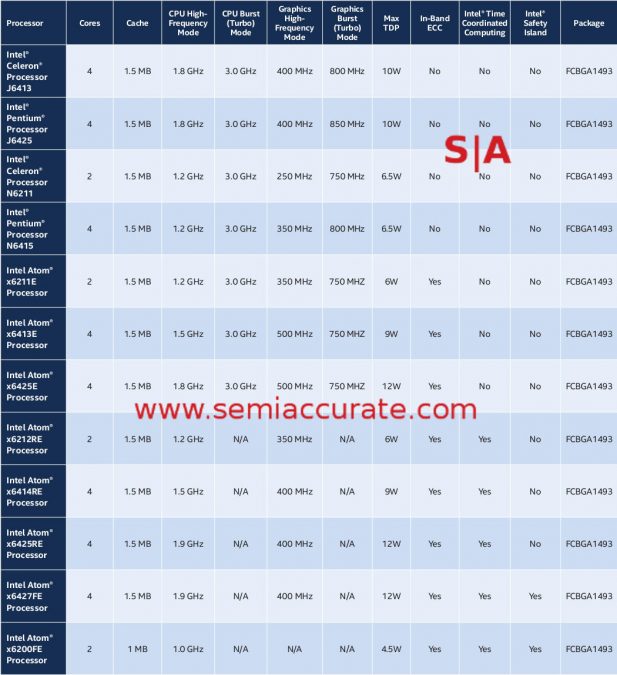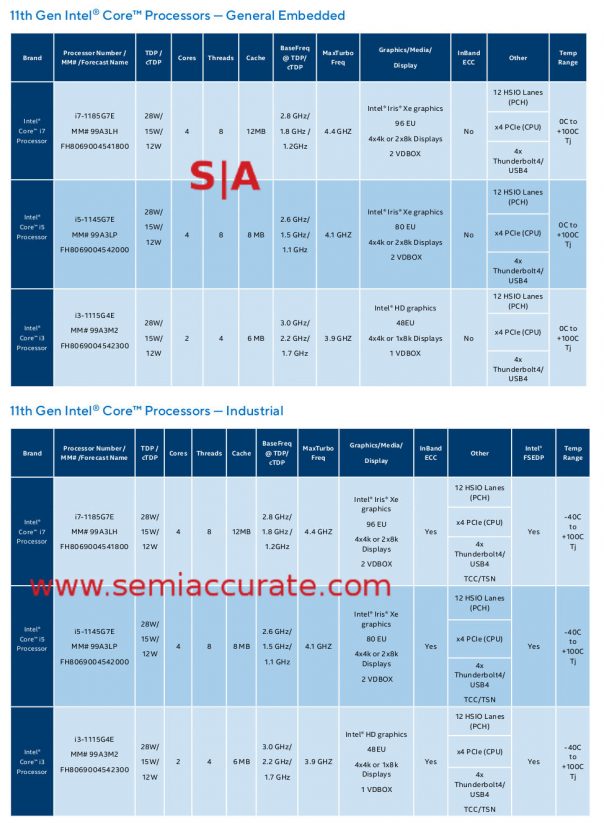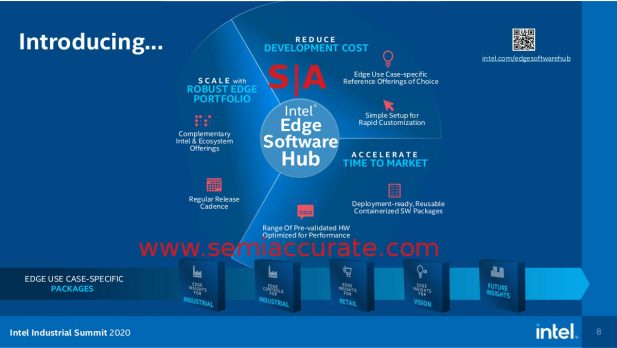 Intel is launching a slew of embedded goodies today including 2 new SoCs and a comprehensive tool suite. More interesting to SemiAccurate is what this briefing shows about the internal state of Intel, and it is telling.
Intel is launching a slew of embedded goodies today including 2 new SoCs and a comprehensive tool suite. More interesting to SemiAccurate is what this briefing shows about the internal state of Intel, and it is telling.
Lets start out with the hardware, two new embedded SoCs, the Atom x6000E and Tiger Lake variants for this market. The Atom appears all new, Tiger is new as well having just been announced for consumers a few weeks ago. Both SoCs come with industrial temp packaging and long availability windows, about what you would expect from embedded parts. Additionally some variants of these new lines have tweaks for safety and realtime compute capabilities.
Intel embedded Atom SKUs
Lets start out with the Atom x6000E, as you can see above there are twelve SKUs with two or four cores and TDPs that range from 4.5-12W. All are based on the Tremont core and have a Gen 11 GPU. This is mainly to support Intel’s push into intelligence at the edge, a large portion of which involves AI and computer vision. However, the x6000E line can drive three monitors. The first four SKUs that are bewilderingly labeled Pentium and Celeron should be ignored, focus on the Atoms with a suffix.
The tree -E parts are the vanilla devices of the bunch and are about what you would expect, embedded variants of the Atom line. When you get to the -RE SKUs, things get a bit more interesting because RE are the realtime variants. These chips are have slightly tweaked firmware and other minor changes to support realtime compute, both hard and soft, if you have the right OS or RTOS. TCC or Time Coordinated Computing and TSN or Time Sensitive Networking are the key features here.
TCC gives a floor for execution time, think of it as a worst case minimum on a per-core and per-system basis. While Intel didn’t go into too much detail on how this is achieved, it probably means Intel tuned it to give up a little peak performance for a lot more ‘fairness’ in some portions of the device. This won’t excite the enthusiast set but it is key to the embedded world, such guarantees are mandatory in this space. TSN is a similar rebalancing of the networking QoS features and essentially provides reliable delivery time at the expense of a small amount of peak performance.
Once again, key to the embedded world, many applications simply need such guarantees. More interestingly, Intel is claiming that these parts will be 5G capable which means this is where we will see the first Mediatek silicon in Intel devices. If you recall that Lakefield was said to have embedded comms on the package, it is likely that the x6000E will do something similar with 5G. The real open question here is whether the construction will be as complex as that SoC or if it will just be an on-package addition. SemiAccurate is guessing Intel will take the simple route at first.
There are a bunch of features that don’t make the headlines similar to TCC and TSN. Cache Allocation technologies, Time Aware GPIO, and PCIe virtual channels all contribute to the overall goal of making things happen consistently and reliably on the Atom SoCs. While all of these things are on ‘standard’ Atoms, they are tweaked in subtle ways for the -RE SKUs and that makes all the difference for the target market.
-RE Atom x6000’s also have two new feature additions, management and ECC. ECC is not new, most Intel products have it but Intel seems to fuse it off and sell it back to you on certain SKUs. Industrial and server Atom parts have had ECC off and on for a while but what is new this time around is that it is in-band ECC (IBECC). This method doesn’t need a ninth DRAM chip or the related controllers, pins, and traces, it just puts the ECC bits in line as part of the memory stream. This costs capacity and speed but gives you reliability. In the embedded space, guess which one is far more important? Nvidia has done similar things in the past to a few Quadro cards and it worked adequately there too.
Update Sept 23, 2020 @ 5;10pm: Only the -RE Atom x6000E’s have IBECC.
Management is also interesting with these Atoms not getting the full vPro suite that the Tiger Lake embedded parts have. Instead embedded Atoms have a more basic in-band and out-of-band system that can perform basic functions like powering up and down, rebooting, and blinking the damn LED that annoys you late at night. For the systems these SoCs are aimed at, it is probably adequate, if you need more, step up to the Tiger Lake based chips.
That brings us to the next level of Atom x6000E, the two -FE SKUs. They have all the goodies that the -RE variants do and add one little bit, the Intel Safety Island. If you haven’t guessed by now, the F in FE stands for Functional as in Functional Safety. The Safety Island is… well we are not really sure, it is likely a re-purposing of the DSP that is used for voice keyword recognition and other bits but it could actually be a really new hardware block. That said it allows these Atoms to meet several fairly high end certifications.
What’s that you ask, you are short of your industry standard names and number combinations for the da… wee… month? Oh good because the x6000FE line is IEC 61508, ISO 13849 (SIL2/Cat.3 PL d certified, SIL3/Cat.4 PL e capable) meaning it more than meets the functional safety requirements you probably have never heard of before reading this. And it has the sticker to prove it. Joke as we might these standards are both really important to some markets and very hard to get. If you need it, Intel has Atoms to sell you that have the stickers you need already applied.
Intel embedded Tiger Lake SKUs
There are six Tiger Lake based SKU, three standard embedded and three industrial ones. The standard versions are the consumer Tiger Lake CPUs with a higher temperature range package and a few firmware tweaks. Nothing much to see here, move along, along to the industrial SKUs which… umm… how do I say this… have the exact same names and numerical codes as the embedded parts but pack significantly different feature sets. Did Intel hire someone from Qualcomm to name these parts?
In any case there are two main differences between Tiger-E and Tiger-I, names we just made up because there seems to be no actual differentiation of the real product names. The -I parts have in-band ECC and FSEDP or Functional Safety Essential Design Package, more on this later. Tiger SKUs also pack TCC, TSN, and don’t have memory encryption turned off. That said it is ironic that the big SoC only has one 2.5GbE and one GbE port the Atom packs 2x GbE and one GbE port.
Back to the really important bits, FSEDP is the one standout feature for Tiger but it is less comprehensive than the functional safety certifications of the Atoms in some ways but more in others. Due to the way the Atoms are sold, mainly as fully contained boards, they can be certified as a device. The Tiger Lake CPUs can be put into boards that will meet certain standards or put in to other devices that don’t meet those fairly high bars. In both cases they are sold as a CPU, not a device, so they can’t have the outright final stickers that the Atoms do. That said Intel has all the documentation, libraries, and whatnot to ease the certification of the end device done and handed to developers on a silver platter. Once again don’t discount how much work this saves and how costly it would be to recreate, this is a big deal to the markets that need it, and that is why FSEDP is so important.
Other than that these two new devices aren’t a big change. They should do the job they were meant to do, AI on the edge, and do it significantly better than before. Tiger comes in 12/15/28W TDP SKUs which dovetails nicely into the Atoms which top out at 12W. The feature sets are a little different but with a little work, both can be bent to do the jobs that the other is capable of albeit at different speeds and power draws.
By this point you are probably wondering what the big deal is about a couple of slightly tweaked SoCs with a few shiny stickers, paperwork, firmware changes, and new packaging. In and of itself the answer would be not too much but Intel is doing right on the tools side with these new devices, or more to the point tools coupled to these new devices.
The tools of the trade
SemiAccurate has told you about OneAPI and that is just the start of the tools for embedded user. Throw in OpenVINO and Open Visual Cloud to meet the AI and vision requirements and you have the start of something interesting. Put it all together under a single umbrella and you have the Intel Edge Software Hub with all the helping hands, tutorials, and sample code you need to do your embedded work. OK, not everything but Intel is usually quite good at this part, their tools tend to be top notch and the Edge Software Hub will probably be right up there. Since most of it is based on existing tools like OneAPI, there should be few teething problems.
If you are not an embedded developer you are probably wondering why this is a big deal, most developers have a similar tool set for their industry, why is this hub different? Realtime and functional safety are the two big ones, both coupled to a style of coding that has very different baseline needs from almost everything most normal humans consider to be code. Management and updates for example are very different on your PC or phone than they are for that camera stuck to the side of that skyscraper 37 floors up.
Functional safety dictates that everything is provable and documented, every change verified, and so on and so forth. Most modern development systems have this buried somewhere but the embedded developer working on functional safety lives this and uses it every day on a level that few if any other verticals do. It’s not that they may someday have to prove that their code can do X, it is more that they will have to do it for every feature and meet exacting standards to get the shiny stickers that they need to keep customers happy and lawyers at bay. Doing this on your own is a long, painful, and expensive process. The fact that Intel does much of it for developers alleviates those three pain points before you get to, “Hello world”.
Doing the low level work for functional safety and documenting it is a huge competitive advantage for Intel, especially since a lot of the tools are free to use. You should think of these embedded offerings not as two SoCs and a tool set but as two SoCs that are effectively part of the tool set, you can’t separate hardware and software without an untenable amount of work. Coupled together the offerings can potentially save months or years of time to market and the attendant costs.
Intel isn’t alone in offering this type of comprehensive package for developers, to one degree or other it is standard in the embedded world but costs and features may vary. The key takeaway today is that Intel is not only putting cutting edge SoCs into this vertical but also pulling in AI and vision as well with dedicated hardware to do it right. This is what it takes to get AI and vision on the edge, it is a lot of work.
By now you have probably forgotten our little crack about the internal state of Intel in the second line of the story. Don’t worry we didn’t forget, and it is a quick one, starting with a history lesson.
Note: The following is for professional and student level subscribers.
Disclosures: Charlie Demerjian and Stone Arch Networking Services, Inc. have no consulting relationships, investment relationships, or hold any investment positions with any of the companies mentioned in this report.
Charlie Demerjian
Latest posts by Charlie Demerjian (see all)
- Qualcomm Is Cheating On Their Snapdragon X Elite/Pro Benchmarks - Apr 24, 2024
- What is Qualcomm’s Purwa/X Pro SoC? - Apr 19, 2024
- Intel Announces their NXE: 5000 High NA EUV Tool - Apr 18, 2024
- AMD outs MI300 plans… sort of - Apr 11, 2024
- Qualcomm is planning a lot of Nuvia/X-Elite announcements - Mar 25, 2024


